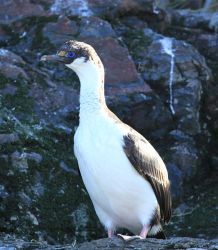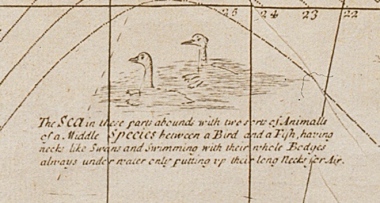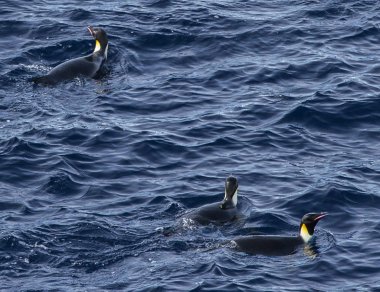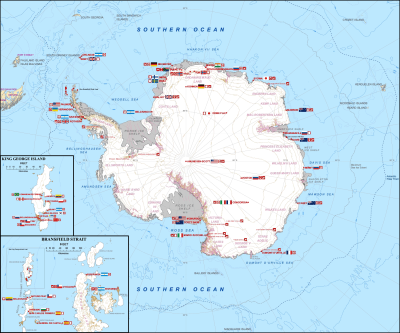Over the next two posts we’ll look at the results of Halley’s voyage, which he published in the form of a sea chart. But before we consider his chart in full, I want to pick out one detail which may help to settle the identity of those mysterious creatures that Halley saw in the South Atlantic.
In a previous post we looked at Halley’s descriptions of three animals – two birds and something akin to a whale – that he’d seen in the seas to the north-west of South Georgia, and I summarised his descriptions as follows:
- a bird he takes to be a penguin with a black head and back, white breast, and a bill like that of a crow; it swims deep, dives on the ship’s approach, doesn’t appear to fly, and has a neck like a swan
- a second bird he also takes to be a penguin, larger than the first, and the colour and size of a “young Cygnett”, it has a bill that hooks downwards, cries like a bittern, and also swims deep, dives on the ship’s approach, doesn’t seem to fly, and has a neck like a swan
- an animal thought by the crew to be a seal but which Halley asserts is not. It bends its tail into a bow, has large fins like a shark and a head like a turtle

Giant petrel with chicks. (Brocken Inaglory/Wikimedia)
While researching that post, I wondered if the second bird might have been a petrel (because of the beak) and some readers suggested that too, but the main objection is that almost every image of petrels shows them flying, which Halley says they don’t do (“either not having wings, or else not commonly useing them”).
Another reader suggested they might have been shags and I think these seem more likely as they resemble penguins and have long necks (I’m looking at the Imperial and South Georgia varieties). They do fly, but the proportion of images of them flying is far lower than it is for petrels.

Imperial Shag, South Georgia. (Liam Quinn/Wikimedia)
In that earlier post I mentioned there was another piece of information about these birds that appears at the end of the voyage, and it appears in Halley’s chart. There, Halley gives a description of the birds and provides a little more detail:
The Sea in these parts abounds with two sorts of Animalls of a Middle Species between a Bird and a Fish, having necks like Swans and Swimming with their whole Bodyes always under water only putting up their long Necks for Air.
Now it seems to me that “a Middle Species between a Bird and a Fish” is a good way to describe penguins – but happily Halley doesn’t just describe his birds, he depicts them too! Here they are:

Extract from Halley’s Atlantic Chart – notice the feet. (© Royal Geographical Society (with IBG) (£), Image S0015919)
Er… oh, well, perhaps they’re not quite my idea of penguins after all. But before I scoff too much at Halley’s illustration, it’s worth remembering that he was trying to describe something he’d never seen before and to people who likewise had never seen such animals before, and so he has to use vocabulary and comparative imagery that were familiar to him and his readers. Additionally, he wasn’t near land when he saw the birds and he hadn’t mentioned seeing any floating ice, so he may only have seen them swimming in the sea, which would have made it very difficult for him to see them properly (have a look at this 36 second film of penguins at sea and you’ll appreciate his difficulty).
If you look closely at the birds, you can see that their beaks are slightly different, and the one on the right has a few tufts on the back of its head, so I wondered if that might have been a type of crested penguin, such as a southern rockhopper?

Rockhopper Penguin. (© Samuel Blanc/Wikimedia)
As to the animal the crew thought was a seal and Halley says is not, what’s curious about that is that he doesn’t call it a whale or whale-like, an animal he would have known – perhaps he was even among the crowd that went to gawp at this poor cetacean stranded in the Thames around 1690. [1]

Broadside, c1690. (© British Museum, Image Z,1.163)
I don’t have any more information about this animal, which Halley’s biographers have suggested might have been a bottlenose whale, a killer whale or a dolphin, although there are problems with each of these identifications – but I have been wondering whether it might have been a Risso’s dolphin? They have a more turtle-like head, a large dorsal fin, and unlike the bottlenose and killer whale are not remarkable in size, something which Halley fails to comment on. An unfamiliar type of dolphin might also explain why Halley doesn’t use the word whale and why the crew think it’s a seal.
But there are three objections to this suggestion: there don’t seem to be many images of them “twisting [their] tayl into a bow” as Halley describes them doing, he may have been outside their range when he saw them, and the sea temperature may have been too cold.
So we haven’t resolved for certain what these creatures were but we have added some new ideas to the list of possibilities. One thing is certain, though, and that’s that no further clues are likely to come from Halley: five months after his return to England, his recollection of these animals was even more confused as we find it minuted that at the Royal Society meeting of 5 February 1701:
Mr Halley said that he saw a kind of Tortoises in the S. of Brazile, having Necks like Swans, and all their bodies under Water. [2]
And for that creature, I think we may need to search among the monsters of medieval cartography, not the seas of the South Atlantic!
UPDATE MARCH 2017: HALLEY VINDICATED!
I rather scoffed at Halley’s depiction of penguins when I wrote this post in 2014, so you’ll imagine my astonishment when I came across a photograph on Twitter that entirely vindicated Halley’s drawing. The photograph was taken by Neil Spencer (@HalleyVIDoc), a doctor based at the Halley Research Station in Antarctica, who was himself surprised to see how penguins swam, tweeting “Didn’t realise penguins swim like ducks when on the surface!” and appending the photographed that demonstrated the point. Neil kindly gave me permission to use his photo – but let’s first remind ourselves of Halley’s own depiction:

Extract from Halley’s Atlantic Chart. (© Royal Geographical Society (with IBG) (£), Image S0015919)
And now here’s Neil’s photograph:

Penguins swimming in Antarctic seas, by Neil Spencer. (Used with permission)
Separated at birth, no? And a lesson learned by me not to dismiss historical descriptions that seem rather naive and amusing (sorry, Edmond!).
If you’re not familiar with the Halley Research Station, it was set up by the Royal Society in 1956 as the British contribution to the International Geophysical Year of 1957/58, and named after Halley in recognition of his voyage to the South Atlantic, and to mark the tercentenary of his birth. Halley came within about 200 nautical miles of South Georgia on his second voyage, and South Georgia is roughly 1,300 nautical miles north of the Halley station (you can find them both on the map below). There have actually been six Halley stations on the Brunt Ice Shelf, and you can read about the history of these bases at the British Antarctic Survey (BAS) website here. The website has lots of information about the scientific work carried out at the station, along with photos of the six Halley bases, and details of the recent relocation of the current base, Halley VI. You might also enjoy (as I did) this look at the evolution of Antarctic bases from wooden huts to sci-fi chic, by the BBC (spot the tube roundel on the Halley III photo!).
Lastly, I wonder what Halley would think if he saw this map of the research stations now scattered all over Antarctica, having voyaged in search of the southern Terra Incognita just 300 years ago.

Map of Antarctic stations – Halley VI is near the coast of the Weddell Sea. (Source: Teetaweepo/Wikipedia)
_______________
[1] The text is well worth a read. You can probably make out the title, A Trew Draught of the Whale as he was seen at Blackwell Dock, and underneath it says:
This Monsterous Fish is 57 foot in Lenght & near 40 foot About, he is more in hight, then in breath, and is taken to be a matter of 50 Tunn in Wight, He was first discover’d near the Bouy of the Nore, Where he was fier’d at by a Kings Yoath so received sum Wound, & made toward the Shoure so came along by ye Hoop & beat himselfe upon ye Sand after that he was Harpoon’d & Taken, then Bought by a Quacor, etc.
[2] Royal Society, JBO/10 p 210.

Pingback: Whewell’s Gazette: Vol. #14 | Whewell's Ghost